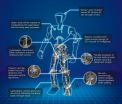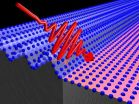(Press-News.org) The 2011 Tohoku tsunami was Japan's deadliest in more than 100 years. Despite an extraordinary level of preparedness by the Japanese, the tsunami caused more than 90 percent of the almost 20,000 fatalities last March.
Georgia Tech Associate Professor Hermann Fritz and his research team are studying the impact of the tsunami on the Sanriku coast.
Using eyewitness video and terrestrial laser scanners from atop the highest buildings that survived the tsunami, Fritz has mapped the tsunami's height and flood zone to learn more about the flow of the devastating currents.
Fritz's measurements and observations could produce flooding forecasts that influence future evacuation plans and building designs, preventing loss of life and property damage in Japan and in other areas of the world susceptible to tsunamis.
"The ultimate goal is to save lives," Fritz said. "In order to do so, we have to have a better understanding of what worked and didn't work. This is the first time we've been able to look at the structural infrastructure designed to protect coastal towns from tsunamis and examine why it didn't work. There's a lot to learn in terms of surviving tsunamis and protecting, evacuating and ultimately saving lives."
Fritz led a reconnaissance team surveying the impact of the tsunami on a fishing town in Kesennuma Bay, where 1,500 people perished. The bay has been hit by historic tsunamis in 1896, 1933, 1960 and 2010—making it the most vulnerable in Japan to both near- and far-field tsunamis. The coastal structures and other mitigation measures on the coast were designed based on conservative, historic high-water marks, rather than probable maximum tsunamis.
From two atop vertical evacuation buildings where eyewitnesses gathered during the tsunami, Fritz and his team used lasers to scan the port and bay entrance, creating a three-dimensional, topographic model of the flood zone.
Using this data, they reconstructed eyewitness videos to determine the varying heights and flow velocities of the tsunami. They determined that the tsunami reached a maximum height of 9 meters, followed by outflow currents of 11 meters per second less than 10 minutes later – a speed which Fritz says is impossible to survive or navigate by vessels.
"What we can learn from the hydrograph is confirmation that the water goes out first, drawing down to more than negative 3 meters on the landward side of the trench, which can make vessels hit ground inside harbors," Fritz said. "During the subsequent arrival of the main tsunami wave, the water rushing back in changed the water level by 40 feet, engulfing the entire city in 12 minutes."
Understanding tsunami impacts will help prepare for future disasters—whether its designing buildings high enough to serve as vertical evacuation points or sea walls and breakwaters strong enough to control the flow of water.
Along with such mitigation measures, Fritz says educating people about tsunamis is key.
"Japan was probably the best prepared for a tsunami," Fritz said. "Indonesia, on the other hand, had no knowledge of tsunamis and it caught people by surprise in 2004. The outcomes of the tsunamis were very different—200,000 killed versus 20,000 killed. That shows educational awareness and preparedness and civil defense mechanisms can work to reduce the death toll. People need to be tsunami-aware."
Fritz worked with researchers from the University of Southern California and Japanese researchers from the University of Tokyo, the Tokyo University of Marine Science and Technology, and the Port and Airport Research Institute, in coordination with the UNESCO-organized International Tsunami Survey Team and the Tohoku University in Sendai.
INFORMATION:
This project was supported in part by the National Science Foundation (NSF) (Award No. 1135768). The content is solely the responsibility of the principal investigators and does not necessarily represent the official views of the NSF.
For more on the anniversary of the Japan disaster, visit www.gatech.edu/experts/japan-anniversary.
END
In both war and peacetime scenarios, fire in the shipboard environment is serious and frequently results in excessive damage and high repair costs because the fire is not detected or controlled adequately. To help further improve future shipboard firefighting capability scientists at the Naval Research Laboratory have formed an interdisciplinary team to develop a humanoid robot that could fight fires on the next generation of combatants. A humanoid-type robot was chosen because it was deemed best suited to operate within the confines of an environment that was deigned ...
Perspective Magazine announces that Holiday Systems International (HSI) has renewed its sponsorship package for the Third Annual Global Networking Expo, GNEX 2013 - The Global Meeting Of Minds. The agreement will provide HSI with exclusive sponsorship of the Perspective Magazine Awards Program and Platinum-level sponsorship for the event, to be held at the world famous Beverly Wilshire - A Four Seasons Hotel on February 4-6, 2013.
"GNEX is in touch with the industry and continues to demonstrate their Expo is valuable to the attendees," said Craig Morganson, ...
Pitney Bowes today announced it is expanding the availability of its Reliant Sorting Solution to the European Market, where its small-footprint design and robust capabilities will help small private posts provide fast, accurate and flexible services to their customers. The Reliant can also meet the needs of in-house and interoffice sorting applications. The Reliant sorter will be shown to European audiences for the first time at Drupa 2012 - Hall 4, Stand C04.
The Reliant Sorter will bring automation and full-integrity to three core market segments - incoming mail, outgoing ...
Rockville, Md. – – Wii remotes are not all about fun and games. Scientists can use them to assess and diagnose children with an abnormal head position caused by eye diseases. As described in a recent Investigative Ophthalmology & Visual Science article, researchers developed a low-cost digital head posture measuring device with Nintendo Wiimotes to help diagnose this condition, medically called ocular torticollis.
"Torticollis occurs in about 1.3% of children," said author, Jeong-Min Hwang, MD, of Seoul National University College of Medicine. "Accurate measurement of ...
RIVERSIDE, Calif. – A team of paleontologists has discovered the oldest animal with a skeleton. Called Coronacollina acula, the organism is between 560 million and 550 million years old, which places it in the Ediacaran period, before the explosion of life and diversification of organisms took place on Earth in the Cambrian.
The finding provides insight into the evolution of life – particularly, early life – on the planet, why animals go extinct, and how organisms respond to environmental changes. The discovery also can help scientists recognize life elsewhere in the ...
Just on the heels of both David Bowie and Freddie Mercury there was Jobriath, the first American folk and glam rock musician to declare himself openly gay in the early 1970's. Self proclaimed as "The True Fairy Of Rock n Roll", Jobriath's story caught the attention of Director/Producer Kieran Turner, who devoted more than two years of his time to produce a documentary that shows how the legacy of this multi-talented musician goes beyond the labels that were hung upon him. Ahead of his time, Jobriath was a pioneer in the very early days of glam rock.
For the ...
In the world of marketing, people who are thinking about sharing product information they find in online advertising are likely to first consider whether the information is relevant to friends and family in their social networks.
The notion of a piece of information, a video clip, amusing photo or informative email going "viral" was initially a purely organic concept where every consumers and users shared such an item to the point where few people would remain unaware of its existence. However, marketing and advertising executives quickly recognized the potential and ...
A research group led by Dr. A. Claudio Cuello of McGill University's Faculty of Medicine, Dept. of Pharmacology and Therapeutics, has uncovered a critical process in understanding the degeneration of brain cells sensitive to Alzheimer's disease (AD). The study, published in the February issue of the Journal of Neuroscience, suggests that this discovery could help develop alternative AD therapies.
A breakdown in communication between the brain's neurons is thought to contribute to the memory loss and cognitive failure seen in people with AD. The likely suspect is NGF ...
Proteins are the molecular building blocks and machinery of cells and involved in practically all biological processes. To fulfil their tasks, they need to be folded into a complicated three-dimensional structure. Scientists from the Max Planck Institute of Biochemistry (MPIB) in Martinsried near Munich, Germany, have now analysed one of the key players of this folding process: the molecular chaperone DnaK. "The understanding of these mechanisms is of great interest in the light of the many diseases in which folding goes awry, such as Alzheimer's or Parkinson's," says Ulrich ...
An international team of physicists has developed a method for taking ultrafast 'sonograms' that can track the structural changes that take place within solid materials in trillionth-of-a-second intervals as they go through an important physical process called a phase transition.
Common phase transitions include the melting of candle wax before it burns and dissolving sugar in water. They are purely structural changes that produce dramatic changes in a material's physical properties and they play a critical role both in nature and in industrial processes ranging from ...



